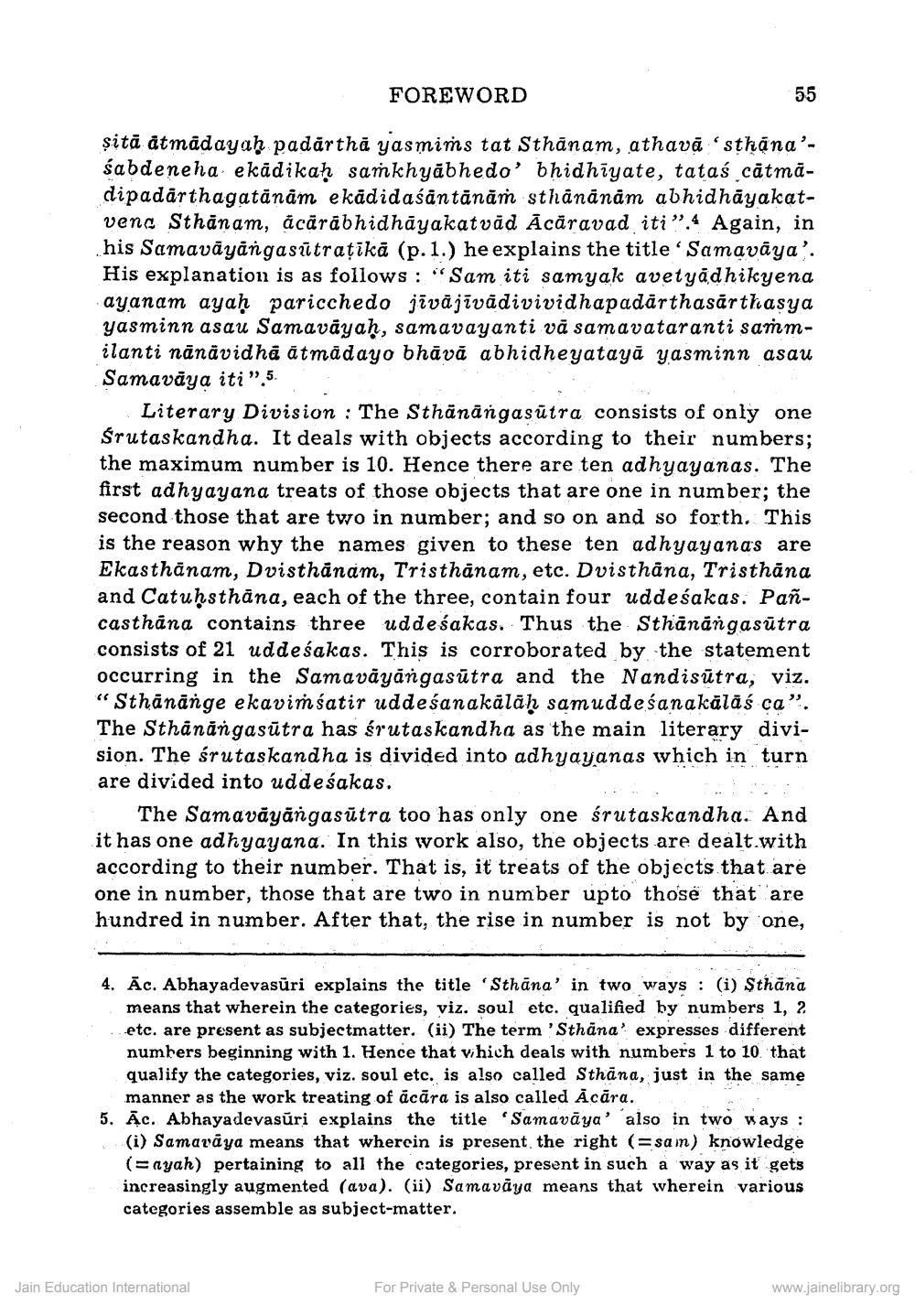________________
FOREWORD
55
șitā åtmadayah padārtha yasmins tat Sthānam, athavasthana'. sabdeneha ekādikan samkhyabhedo' bhidhiyate, tataś catma
ipadārthagatāmām ekdidasẵntặnăm thamāmām abhidhagak venc Sthānam, ácarabhidhāyakatvad Ācāravad iti”.4 Again, in his Samavāyāngasūtraţikā (p. 1.) he explains the title 'Samavāya'. His explanation is as follows: "Sam iti samyak avetyādhikyena ayanam ayah paricchedo jīvājīvādivividhapadārthasarthasya yasminn asau Samavāyah, samavayanti vā samavataranti sammilanti nānāvidhā ātmādayo bhāvā abhidheyatayā yasminn asau Samavāya iti”.5.
Literary Division : The Sthânăngasutra consists of only one Śrutaskandha. It deals with objects according to their numbers; the maximum number is 10. Hence there are ten adhyayanas. The first adhyayana treats of those objects that are one in number; the second those that are two in number; and so on and so forth. This is the reason why the names given to these ten adhyayanas are Ekasthānam, Dvisthanam, Tristhānam, etc. Dvisthana, Tristhāna and Catuhsthāna, each of the three, contain four uddesakas. Pañcasthana contains three uddeśakas. Thus the Sthânăngasūtra consists of 21 uddesakas. This is corroborated by the statement occurring in the Samavāyāngasūtra and the Nandisūtra, viz. “Sthânănge ekaviņśatir uddeśanakālāḥ samuddeśanakālāś ca”. The Sthânăngasūtra has śrutaskandha as the main literary division. The śrutaskandha is divided into adhyayanas which in turn are divided into uddeśakas.
The Samavāyāngasūtra too has only one śrutaskandha. And it has one adhyayana. In this work also, the objects are dealt with according to their number. That is, it treats of the objects that are one in number, those that are two in number upto those that are hundred in number. After that, the rise in number is not by one,
4. Āc. Abhayadevasúri explains the title 'Sthāna' in two ways : (i) Şthāna
means that wherein the categories, viz. soul etc. qualified by numbers 1, 2 etc. are present as subjectmatter. (ii) The term 'Sthana? expresses different numbers beginning with 1. Hence that vihich deals with numbers 1 to 10 that qualify the categories, viz. soul etc. is also called Sthāna, just in the same
manner as the work treating of acāra is also called Acāra. 5. Ac. Abhayadevasúri explains the title 'Samavāya' also in two ways :
(i) Samarāya means that wherein is present the right (=san) knowledge (=ayah) pertaining to all the categories, present in such a way as it gets increasingly augmented (ava). (ii) Samavāya means that wherein various categories assemble as subject-matter.
Jain Education International
For Private & Personal Use Only
www.jainelibrary.org




